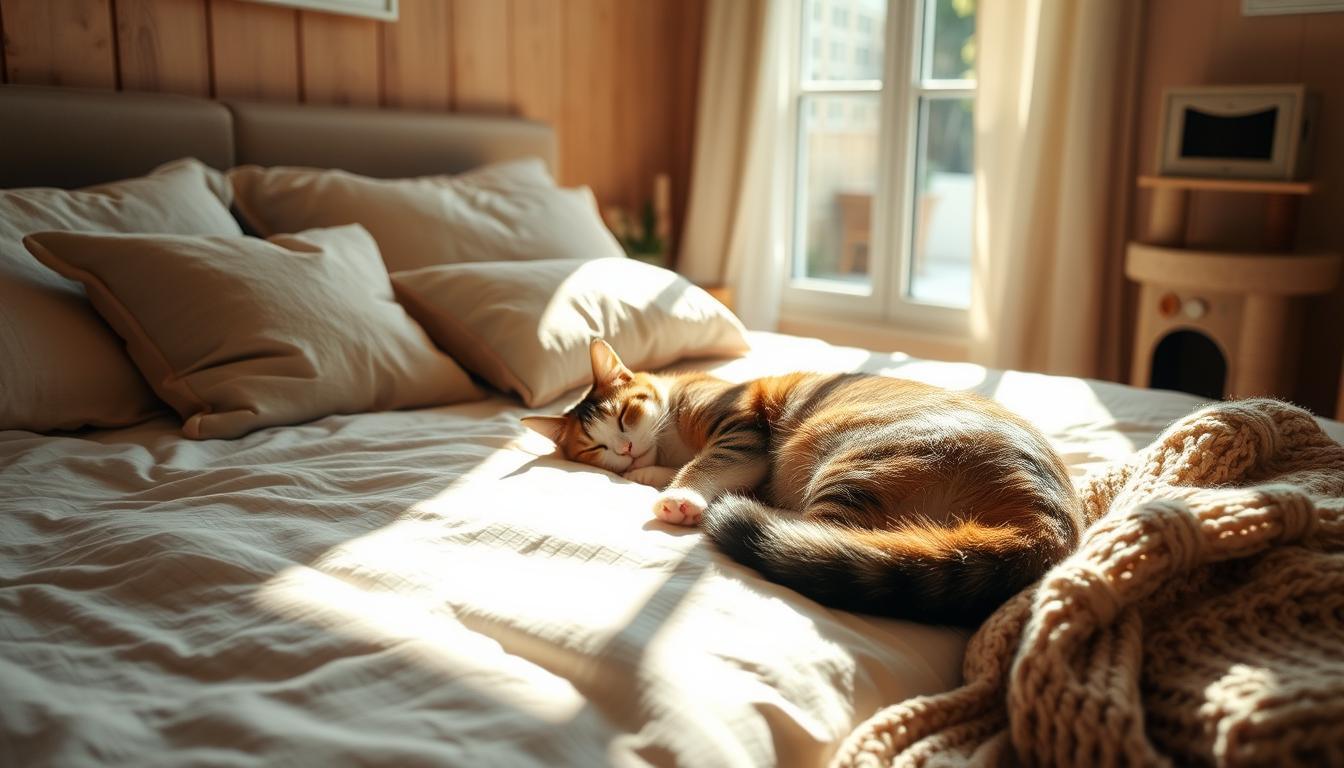A staggering 62% of pet owners, mostly with cats or dogs, let them sleep in their bedrooms1. This fact, from the Center for Sleep Medicine at Mayo Clinic in Arizona, shows how common it is for cats to share their owners’ beds1. But, is it cruel to keep cats out of the bedroom?
Cats sleep a lot, 12 to 18 hours a day1. They’re not night animals but are most active at twilight and dawn1. This can mess up their owners’ sleep, as cats might want to play or get attention at night.
But, having cats in the bedroom can have good sides. A study by the Human Animal Bond Research Institute (HABRI) found that animals can make people feel safer, especially those with mental health issues1. Also, owning a cat might lower the risk of heart attacks, as a 10-year study by the University of Minnesota’s Stroke Institute in Minneapolis showed1.
However, there are downsides to having cats in your bed. The Sleep Foundation says the best sleeping temperature is 65 degrees Fahrenheit1. Cats, with a body temperature of 101 to 102.5 degrees, can make it hard to sleep by warming up the bed1. Plus, cat dander and fungi in bedding can make allergies worse, according to the Cleveland Clinic1.
To deal with these issues, pet owners can use air filters, wash bedding weekly, or teach cats to sleep in certain parts of the bed1. For older cats that might not like changes, getting advice from a vet on sleep aids can help1.
In the end, whether to let cats in the bedroom or not is up to each owner. It’s important to think about what’s best for the cat and the owner. By understanding cats’ sleep habits and the pros and cons of having them in the bedroom, owners can make a good home for both themselves and their cats.
Key Takeaways
- Over half of pet owners allow their cats or dogs to sleep in their bedrooms, highlighting the prevalence of this practice.
- Cats are crepuscular, meaning they are most active at dusk and dawn, which can lead to disruptions in their owners’ sleep schedules.
- The presence of animals can provide a sense of security for individuals with mental health issues and may reduce the risk of heart attacks in cat owners.
- Cats’ higher body temperature and the accumulation of dander and fungal organisms in bedding can potentially disrupt sleep quality and exacerbate allergies.
- Strategies such as using air filters, washing bedding regularly, and training cats to sleep in designated areas can help mitigate the challenges of sharing a bedroom with a cat.
Understanding Feline Sleep Habits and Behavior
Cats are beloved pets known for their unique sleep patterns and behaviors. Many think cats are nocturnal, but they are actually crepuscular animals. This means they are most active at dawn and dusk and rest during the day2. Their sleep schedule comes from evolution, as their wild ancestors hunted in dim light for stealth2.

Domestic cats sleep for 12-18 hours a day3. Kittens and senior cats sleep more than adult cats because of their energy needs3. Cats can nap for short periods or seem asleep for longer. They also change their sleeping spots within their territory3.
Factors Affecting Cat Sleep Patterns
Several factors can change a cat’s sleep duration and patterns, including:
- Age: Kittens and senior cats sleep more than adult cats.
- Health: Health issues can affect sleep habits.
- Environment: Cats prefer warm, comfortable, elevated, and safe places3. Some even sleep outdoors in the sun during summer3.
Disturbing sleeping cats can cause distress and defensive reactions in some instances.
Domesticated cats adjust to their human family’s hours but still show crepuscular behavior2. Playing with a cat before bed can help them sleep better. Ignoring their requests for attention or food can stop unwanted behavior2.
Feeding a cat before bed can help them digest and reduce night-time activity2. Keeping a cat out of the bedroom at night can stop sleep disturbances and reduce night-time disruptions2.
The Pros of Allowing Cats in the Bedroom
Having your cat in your bedroom can bring many benefits. It strengthens the human-cat bond and boosts your well-being. It allows for more time together, deepening your connection.
Studies show pets can improve mental health. They reduce loneliness, lower stress, and boost mood4. Around 50% of Americans share their beds with pets4. Many feel safer and less stressed with their cats nearby5.

Strengthening the Human-Cat Bond
Letting your cat sleep with you can make your bond stronger. Cats seek their owners’ company, and bed-sharing is comforting for both. It helps you understand and appreciate your cat’s personality and needs better.
Potential Health Benefits for Humans
Bed-sharing with cats can also be good for your health. Their purring can soothe you and aid in healing5. Cats also keep you warm, thanks to their higher body temperature5.
Creating a Sense of Security for Cats
Sharing your bedroom with your cat can make them feel secure. Cats are social and seek comfort from their owners. By letting them sleep with you, you offer a safe space, reducing their anxiety4.
However, consider allergies, asthma, and personal preferences before deciding5. Weighing the pros and cons helps create a nurturing space for both you and your cat. This supports a strong human-cat bond and well-being.
The Cons of Keeping Cats Out of the Bedroom
Sharing a bedroom with your cat can be cozy. Yet, there are downsides. These include disrupted sleep, allergen exposure, and the chance of accidents.
Disrupted Sleep Quality for Humans
Cats are most active at dawn and dusk1. This can disturb their owners’ sleep. Cats might paw at faces or feet at night. Their body heat can also be uncomfortable for some.
Adults need seven or more hours of sleep each night, the CDC says1. Sleeping less than 7 hours can lead to health issues like heart attacks and depression1.
Potential Allergen Exposure
Cats in the bedroom can spread allergens like dander and fur. This can worsen asthma and allergies. Keeping the bedroom door closed and giving cats their own beds can help.
It’s also good to have a room for each cat, plus an extra one6. This reduces allergen exposure.
Risks of Accidental Injuries
There’s a small chance of injury if a cat feels threatened. To avoid this, set clear boundaries and make cats feel safe. Giving them a toy with your scent can help6.
Make sure the cat’s room is safe from hazards like toxic plants6. This keeps both you and your cat safe.
Despite risks, many pet owners, especially cat owners, let their pets sleep with them1. A study showed cat owners might live longer than non-owners1. Whether to let cats in the bedroom depends on your situation and what’s best for you and your cat.
Tips for Managing Cat Access to the Bedroom
Managing your cat’s bedroom access is a delicate task. But with the right strategies, you can create a peaceful space for both you and your cat. Studies show that about 68% of cat owners keep their cats out of the bedroom to keep it clean and avoid sleep disruptions7. Here are some tips to help you manage this:
Providing Alternative Sleeping Arrangements
One effective way to keep your cat out of the bedroom is to offer cozy alternatives. You can provide cat beds, plush hiding huts, or even a dedicated cat room. When introducing a new cat, it’s crucial to give them a safe space to adjust. In fact, 100% of cats benefit from a safe space, like a small, quiet room, when first introduced to a new home8.
By creating a welcoming space for your cat, you can lessen their desire to sleep in your bedroom.
Establishing Consistent Boundaries
Setting clear boundaries with your cat is essential. If you’ve decided to keep your bedroom off-limits, stick to this rule always. Veterinarians suggest that 92% of cat owners use positive reinforcement to enforce no-cat zones7. Reward your cat with treats or praise when they sleep in their designated area.
Also, 79% of cat owners use remote control training tools, like aversive training, to keep cats out of certain areas7.
| Aversive Training Method | Percentage of Cat Owners Using |
|---|---|
| Bad smells (e.g., citrus scents) | 43% |
| Unpleasant tastes (e.g., hot sauce) | 32% |
| Textures (e.g., aluminum foil) | 25% |
Only 18% of cat owners use surprise tactics like loud noises or water sprays to enforce no-cat zones. This is because opinions on their effectiveness vary7.
Addressing Specific Cat Behaviors
When dealing with specific cat behaviors, like scratching at the bedroom door or meowing too much, find the cause. Denying a cat access to a room can stress them, leading to bad behavior elsewhere9. Instead, use positive training methods. Make the room a pleasant place with treats, so your cat associates it with good things.
About 55% of cat owners give their cats alternative options like scratching posts, cat trees, and beds. This helps redirect their behavior and reduces unwanted bedroom access.
Remember, every cat is unique, and what works for one may not work for another. Be patient, consistent, and willing to adapt your approach as needed.
By combining alternative sleeping arrangements, consistent boundaries, and behavioral modifications, you can manage your cat’s bedroom access. This creates a peaceful nighttime routine for everyone.
Conclusion
Deciding whether to keep a cat out of the bedroom is a personal choice. It depends on many things like the cat’s needs, the cat’s health, and how well the owner sleeps. Some people love having their cats in bed for the bonding and health benefits. Others need quiet and clean air without cat allergens.
In the United States, 63% of cats live indoors10. Indoor cats need lots of space to play, climb, and rest. They need big rooms and climbing spots11.
Finding a balance is key for both the cat and the owner. Knowing how cats sleep and the good and bad of sharing a bed helps. Cats need exercise, toys, and mental games to stay happy11. They also need daily playtime with their owners11.
Creating a fun and safe space for cats is important. This includes teaching them to accept closed doors. This helps them feel secure and happy.
Keeping a cat out of the bedroom isn’t cruel if the cat’s needs are met. Owners should think about their cat’s personality, health, and needs. This way, they can create a loving home for both themselves and their cats.
FAQ
Is it cruel to keep my cat out of the bedroom at night?
Do cats need access to their owners’ bedrooms to feel secure?
Can keeping my cat out of the bedroom at night harm our relationship?
How can I train my cat to sleep in a designated area outside the bedroom?
Will keeping my cat out of the bedroom help with my allergies?
My cat keeps meowing and scratching at the bedroom door at night. What should I do?
Source Links
- The dangers of sleeping with your cat in the bed, from a feline expert – https://www.newsweek.com/cat-sleeping-owner-bed-1828090
- Are Cats Nocturnal? The Answer Might Surprise You | Purina – https://www.purina.co.uk/articles/cats/behaviour/common-questions/are-cats-nocturnal
- Cats and Sleep – Behaviour Help & Advice | Cats Protection – https://www.cats.org.uk/help-and-advice/cat-behaviour/cats-and-sleep
- Should You Let Your Cat Sleep in Bed with You? – https://www.healthline.com/health-news/should-you-let-your-cat-sleep-in-bed-with-you
- Should I Let My Cat Sleep With Me? Weighing the Pros and Cons – https://www.kinship.com/cat-behavior/should-i-let-my-cat-sleep-with-me
- 10 Do’s & Don’ts of Confining a Cat to a Room at Night (Vet-Reviewed) – Catster – https://www.catster.com/cat-health-care/dos-and-donts-of-confining-a-cat-to-a-room-at-night/
- 5 Tips for Enforcing No-Cat Zones – https://www.webmd.com/pets/cats/features/enforcing-no-cat-zones
- Moving with Your Cat – San Francisco SPCA – https://www.sfspca.org/resource/moving-with-your-cat/
- How to Keep Cats out of Rooms: 12 Steps (with Pictures) – wikiHow – https://www.wikihow.com/Keep-Cats-out-of-Rooms
- Indoors or Outdoors? An International Exploration of Owner Demographics and Decision Making Associated with Lifestyle of Pet Cats – https://pmc.ncbi.nlm.nih.gov/articles/PMC7909512/
- Is It Cruel to Keep My Cat Indoors? Vet-Reviewed Verdict & Facts – Catster – https://www.catster.com/cat-health-care/is-it-cruel-to-keep-cat-indoors/


